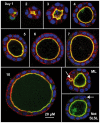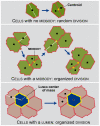MDCK cystogenesis driven by cell stabilization within computational analogues
- PMID: 21490722
- PMCID: PMC3072361
- DOI: 10.1371/journal.pcbi.1002030
MDCK cystogenesis driven by cell stabilization within computational analogues
Abstract
The study of epithelial morphogenesis is fundamental to increasing our understanding of organ function and disease. Great progress has been made through study of culture systems such as Madin-Darby canine kidney (MDCK) cells, but many aspects of even simple morphogenesis remain unclear. For example, are specific cell actions tightly coupled to the characteristics of the cell's environment or are they more often cell state dependent? How does the single lumen, single cell layer cyst consistently emerge from a variety of cell actions? To improve insight, we instantiated in silico analogues that used hypothesized cell behavior mechanisms to mimic MDCK cystogenesis. We tested them through in vitro experimentation and quantitative validation. We observed novel growth patterns, including a cell behavior shift that began around day five of growth. We created agent-oriented analogues that used the cellular Potts model along with an Iterative Refinement protocol. Following several refinements, we achieved a degree of validation for two separate mechanisms. Both survived falsification and achieved prespecified measures of similarity to cell culture properties. In silico components and mechanisms mapped to in vitro counterparts. In silico, the axis of cell division significantly affects lumen number without changing cell number or cyst size. Reducing the amount of in silico luminal cell death had limited effect on cystogenesis. Simulations provide an observable theory for cystogenesis based on hypothesized, cell-level operating principles.
Conflict of interest statement
The authors have declared that no competing interests exist.
Figures












Similar articles
-
Computational investigation of epithelial cell dynamic phenotype in vitro.Theor Biol Med Model. 2009 May 28;6:8. doi: 10.1186/1742-4682-6-8. Theor Biol Med Model. 2009. PMID: 19476639 Free PMC article.
-
A computational approach to resolve cell level contributions to early glandular epithelial cancer progression.BMC Syst Biol. 2009 Dec 31;3:122. doi: 10.1186/1752-0509-3-122. BMC Syst Biol. 2009. PMID: 20043854 Free PMC article.
-
Role of fibronectin deposition in cystogenesis of Madin-Darby canine kidney cells.Kidney Int. 1999 Jul;56(1):92-103. doi: 10.1046/j.1523-1755.1999.00520.x. Kidney Int. 1999. PMID: 10411683
-
The microenvironmental determinants for kidney epithelial cyst morphogenesis.Eur J Cell Biol. 2008 Apr;87(4):251-66. doi: 10.1016/j.ejcb.2007.11.004. Epub 2008 Jan 8. Eur J Cell Biol. 2008. PMID: 18191498 Free PMC article.
-
In silico cancer research towards 3R.BMC Cancer. 2018 Apr 12;18(1):408. doi: 10.1186/s12885-018-4302-0. BMC Cancer. 2018. PMID: 29649981 Free PMC article. Review.
Cited by
-
A hybrid physics-based and data-driven framework for cellular biological systems: Application to the morphogenesis of organoids.iScience. 2023 Jun 19;26(7):107164. doi: 10.1016/j.isci.2023.107164. eCollection 2023 Jul 21. iScience. 2023. PMID: 37485358 Free PMC article.
-
In silico drug absorption tract: An agent-based biomimetic model for human oral drug absorption.PLoS One. 2018 Aug 31;13(8):e0203361. doi: 10.1371/journal.pone.0203361. eCollection 2018. PLoS One. 2018. PMID: 30169515 Free PMC article.
-
Creation of trophectoderm, the first epithelium, in mouse preimplantation development.Results Probl Cell Differ. 2012;55:165-84. doi: 10.1007/978-3-642-30406-4_9. Results Probl Cell Differ. 2012. PMID: 22918806 Free PMC article. Review.
-
Agent-based modeling: a systematic assessment of use cases and requirements for enhancing pharmaceutical research and development productivity.Wiley Interdiscip Rev Syst Biol Med. 2013 Jul-Aug;5(4):461-80. doi: 10.1002/wsbm.1222. Epub 2013 Jun 4. Wiley Interdiscip Rev Syst Biol Med. 2013. PMID: 23737142 Free PMC article. Review.
-
Mistargeting of a truncated Na-K-2Cl cotransporter in epithelial cells.Am J Physiol Cell Physiol. 2018 Aug 1;315(2):C258-C276. doi: 10.1152/ajpcell.00130.2018. Epub 2018 May 2. Am J Physiol Cell Physiol. 2018. PMID: 29719172 Free PMC article.
References
-
- Gin E, Tanaka EM, Brusch L. A model for cyst lumen expansion and size regulation via fluid secretion. J Theor Biol. 2010;264:1077–1088. - PubMed
-
- Wang AZ, Ojakian GK, Nelson WJ. Steps in the morphogenesis of a polarized epithelium. I. uncoupling the roles of cell-cell and cell-substratum contact in establishing plasma membrane polarity in multicellular epithelial (MDCK) cysts. J Cell Sci. 1990;95:137–151. - PubMed
Publication types
MeSH terms
Grants and funding
LinkOut - more resources
Full Text Sources

